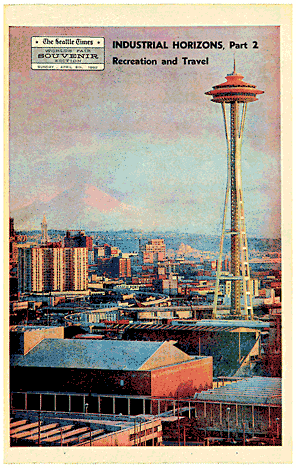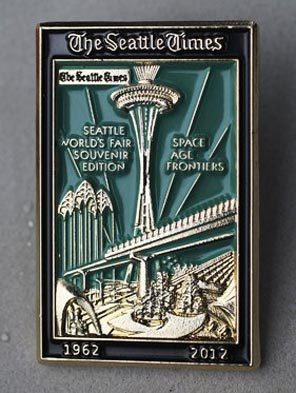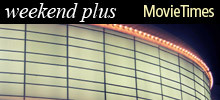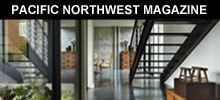Originally published April 14, 2012 at 8:04 PM | Page modified April 15, 2012 at 9:31 AM
1962 Seattle World's Fair: Century 20 was cool, too
It's the 50th anniversary of the Seattle World's Fair, a time when the city was flying high with Space Age optimism. We're marking the occasion by revisiting The Seattle Times' souvenir edition, published shortly before the fair opened April 21, 1962.
Seattle Times staff
Take an 'Industrial Horizons, Part 2' quiz
Attendance at the 1962 Seattle World's Fair hit 9.6 million. The number of people taking this World's Fair quiz will be less, but everyone will be a winner. We've rigged it that way, with Space Age ingenuity, as a reward to our readers. This final quiz is based, as were the previous four in this series, on what's inside the section being featured. Today that's "Industrial Horizons, Part 2."1) A story about the future of Seattle said "... will be a problem." What was that problem?
A) Smog
B) Smug
C) Transportation
2) A story headlined "Doubters Go Into Hiding As Fair Becomes Reality" quoted a Spokane legislator mocking the Seattle World's Fair as:
A) "A glorified carnival of short duration."
B) "The laughing stock of the United States."
C) "A profligate waste of public funds."
3) An advertisement for a relatively rare and small import car said that you can "Pick up your Volkswagen ... "
A) and carry it around.
B) in Europe.
C) for only $1,595.
1962 SPECIAL SECTION
When the world came to Seattle

On April 21, 1962, the gates opened to a World's Fair in Seattle that left an indelible stamp on the city's image and future.
For 184 days, locals and visitors alike marveled at the Space Needle, the Monorail, the "World of Tomorrow" pavilions, and the "Spacearium."
Days before the opening, The Seattle Times published a 152-page "Seattle World's Fair Souvenir Edition" that was packed with information about the fair as well as predictions for the future. We're celebrating the anniversary by revisiting that section:
![]()
This is the last of a five-part series on the 50th anniversary of the 1962 Seattle World's Fair. The series revisits The Seattle Times' souvenir edition that was published before the fair opened on April 21, 1962.
Pictures of sailboats gliding on Lake Washington, a panoramic view of Elliott Bay and a woman reeling in a steelhead don't exactly scream "Space Age."
But Seattle in 1962 had a lot more to offer than just a World's Fair where most everything was blasting off for the future. What later became Seattle Center also was the center of a scenic wonderland that was the featured attraction outside the Century 21 fairgrounds.
That's why the final section we're featuring in this series exploring the 152-page souvenir edition of The Seattle Times focused on the here and now of the 20th century. And some other stuff.
The 16-page section's title — "Industrial Horizons, Part 2, Recreation and Travel" — hints at the fun mishmash of stories, photos and advertisements inside.
Here is where salmon, steel mills and suburbs come together. Where you can read about Seattle, "the gateway to anywhere," Shelton, "the gateway to the Olympics," and even the new state of Hawaii, where you can have a "foreign vacation" without the need for "passports, visas or shots."
There are ads for famed local resorts and restaurants, many of them now just faded memories, and a story about a retired dry cleaner who promised to take about 100 people to dinner at the Space Needle.
"I don't know what they will charge, but I'm laying aside $1,000 just for that purpose," said Calvin J. Ingalls (whose home address was included, too, in case you wanted to get in line).
Next to a story about how Puget Sound was expected to be laced by bridges in the future is an article about the "Mother of the Space Needle" who brought the ironworkers "pies on Thanksgiving and fruitcakes for Christmas." The ironworkers returned the favor by giving Mrs. Ethel Lyons, a retired Seattle schoolteacher, one of their hard hats.
It was a time when nearby "semirural" islands in Puget Sound — Bainbridge, Vashon and Whidbey — were drawing attention and speculators from the big city, according to one story: " 'Our island is in the business of importing — importing dollars from Seattle,' a Bainbridge banker said."
And dollars went far back then. An ad placed right next to the Bainbridge story said that you could rent a Chevrolet at Letz Rent-A-Car for only $8 a day!
Easily overlooked in this section — which promotes such things as our hydroplane racing, fishing and hunting ("Washington Top State for Hunters"); traveling to exotic, far-off places ("250,000 lakes in Ontario!") and buying huge American-made cars ("Custom-Made For the Big Car Man") — is a little World's Fair-bashing.
Today it might be something that would go viral on the Internet and turn into a media feeding frenzy, pitting two great cities against each other.
But in 1962, some derogatory comments from a couple of prominent New Yorkers were nearly ignored. They are mentioned in a teeny four-paragraph story with a tiny headline, "War of the Words: Gov. Rockefeller Lauds, But Others Belittle, Fair" that is squeezed onto a page featuring two dramatic photos of the Bethlehem Steel plant in Seattle by legendary Seattle Times photographer Josef Scaylea.
The story says that Dorothy Kilgallen, a well-known newspaper columnist and game-show panelist, "remarked that nobody would drive across the country just to see some science exhibits."
But times were changing. The story also said that New York's U.S. Sen. Kenneth Keating initially called the Seattle World's Fair "small time," but later praised it after being "challenged" by the two senators from Washington state, Henry Jackson and Warren Magnuson.
Seattle was getting some big-time respect, and its lofty place in the modern world was driven home two pages away in a full-page ad by Continental Can Company.
It was titled "How Seattle Took a Giant Step" and featured a huge picture of a footprint on what looks like the surface of the moon, seven years before Neil Armstrong set foot there.
"What makes progress?" asks the can conglomerate's ad that ran April 8, 1962. "The answer is people ... people with ability to dream ... and determination to work."
Thirteen days later, the fair opened and the world saw Seattle's dream come true. And we're still dreaming and still working.
Bill Kossen has a dream of doing this again on the 100th anniversary of the World's Fair. 206-464-2331 or bkossen@seattletimes.com. On Twitter @BillKossen












